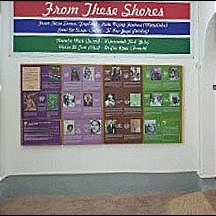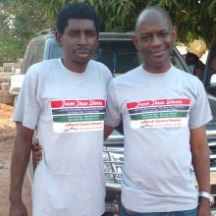During the Sunday, March 5 opening ceremonies for the “From These Shores” exhibit at the Juffureh Slavery Museum, Hassoum Ceesay, Director General, National Centre for Arts and Culture in The Gambia, proclaimed, “This exhibit raises the museum’s standard to a new level.” The historic markers the exhibit crosses include Africanization, appearance, and internet presence.
In addition to calling the exhibit in the colonial language, English, the display is also titled in six local languages, Mandinka, Serer, Wollof, Jola, Aku, and Fula. The exhibit is also titled in French, the colonial language of neighboring sister-nation Senegal. “For the first time, the museum’s exhibit has been decolonized,” declared Ceesay.
POHGEP created and donated the exhibit with funds bequeathed by POHGEP board member Kevin Turner, Esquire.
He says the more inclusive title will improve access to the exhibit since less than 40 percent of Gambians can communicate in English. “From These Shores, or “Kabo Nying Fankas,” in Mandinka, also includes a panel on the N’ko script, the first of such panel in the Juffureh, North Bank, The Gambia institution. N’ko is used to write in the Manding languages of which Mandinka is one and is the most dominate language in the West African nation.
The images in the display include photographs and paintings created just for “Fi Lan Jogei” (Wollof) from black and white photos to colorful acrylics and air brush portraits. The images also reflect the diversity of the various artists.
The 12-panel artistic “Kapanakeh Flaf” (Jola) celebrates the accomplishments of 18 known and lesser-known Africans in the diaspora across time and geography on lightweight, colorful, sintra board. Ceesay added that the technique used to create the display “raises the standards via text, photo production, display method, color scheme, and aesthetics.”
“Nomobo Mak,” (Serer) in also making history by being digitally accessible. The exhibit along with “West Africans in Early America,” also created by The Port of Harlem Gambian Education Partnership (POHGEP), are online. Panels in the physical exhibits include QR codes, which cellphone users can use to quickly access and share both displays online. “This means a lot because it takes our exhibition into the digital age and that’s exactly where we ought to be and sets the standard for future exhibitions,” added Ceesay.
Port of Harlem Exhibit Breaks Colonial Mode and Makes History


POHGEP created and donated the exhibit with funds bequeathed by POHGEP board member Kevin Turner, Esquire. POHGEP also provided locally printed T-shirts with the exhibit logo to local teachers and staff, and booklets and pencils for local students. Ironically, many of the museum’s Gambian visitors come from distant villages. The t-shirts, says site supervisor Patrick Gomez, “will help motivate many from around here to visit the museum.”
“International tourism is a major source of revenue for The Gambia and the museum and we are ecstatic to lend another hand to Ceesay by creating another educational and cultural enhancement to the Juffureh Museum,” says POHGEP president Wayne Young. Young is also publisher of Port of Harlem magazine, an inclusive, diverse, panAfrican publication, which is POHGEP’s chief business sponsor. “Werin Di Cam,” (Aku) and “West Africans in Early America,” are part of the museum’s permanent collection. Timbooktoo bookshop in New Bakau, Kanifing Municipal Council, The Gambia as well Mansa Kunda Restaurant in Takoma Park, Maryland USA also display one of the twelve panels from “Ewri Ga Sengo” (Fula).
Radio Interview:
March 02, 2023
Coffee Time with Peter Gomez
West Coast Radio - Kotu, The Gambia
Gomez and Young talk about the "From These Shores" exhibit (starting from about 24 minutes to 38 minutes)
Experience Senegal and Gambia with Port of Harlem: during Tobaski (Eid al-Adha), Mon, Jun 17, 2024
More about Tobaski!: Is It Christmas, Memorial Day, or Halloween? No, It’s Tobaski!
“International tourism is a major source of revenue for The Gambia and the museum and we are ecstatic to lend another hand to Ceesay by creating another educational and cultural enhancement to the Juffureh Museum,” says POHGEP president Wayne Young. Young is also publisher of Port of Harlem magazine, an inclusive, diverse, panAfrican publication, which is POHGEP’s chief business sponsor. “Werin Di Cam,” (Aku) and “West Africans in Early America,” are part of the museum’s permanent collection. Timbooktoo bookshop in New Bakau, Kanifing Municipal Council, The Gambia as well Mansa Kunda Restaurant in Takoma Park, Maryland USA also display one of the twelve panels from “Ewri Ga Sengo” (Fula).
Radio Interview:
March 02, 2023
Coffee Time with Peter Gomez
West Coast Radio - Kotu, The Gambia
Gomez and Young talk about the "From These Shores" exhibit (starting from about 24 minutes to 38 minutes)
Experience Senegal and Gambia with Port of Harlem: during Tobaski (Eid al-Adha), Mon, Jun 17, 2024
More about Tobaski!: Is It Christmas, Memorial Day, or Halloween? No, It’s Tobaski!

Advertisers | Contact Us | Events | Links | Media Kit | Our Company | Payments Pier
Press Room | Print Cover Stories Archives | Electronic Issues and Talk Radio Archives | Writer's Guidelines






